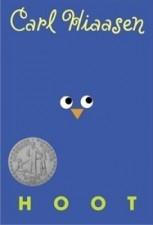- Home
- Tutorial
- Resource Guides
- Focus Areas
- LSF Programs
-
Professional
Development - Review Process
-
A project of LSF

Search for Resources
Description
Roy is the bullied new kid in this Southern Florida suburb. As his face is being smushed into the bus window he sees a barefooted, running boy. Roy is intrigued and seeks him out. It turns out this boy, Mullet Fingers is actually a runaway and an environmental warrior working on behalf of some very lucky burrowing owls. Beatrice is Mullet Finger's stepsister. She and Roy help Mullet Fingers to expose the Pancake Factory as environmental lawbreakers, thus saving the owls and creating a preserve.
Beware. The adults, with the exception of Roy's caring parents, are presented with all their disfunctionality showing Hiaasen's writing is as always, simple, rollickingly engaging, and accessible.
Click here for more information regarding the author's books, school visits, or teaching resources.
General Assessment
Recommendation of how and where to use it
Use Hoot as a catalyst for learning about habitat loss.
- Extend: Look at pictures of Florida past and present. Discuss: Learn what the everglades are and were.
- Extend:Localize by looking at your community past and present. Learn about your ecosystem.
- Extend:Take a walk in your neighbourhood to examine where wildlife lives. Remember to look for all classes of animals. Diversity means healthy.
- Extend:Learn about the animals displaced by your human community.
- Action: Begin some schoolyard plantings to welcome local species of animal back into the neighbourhood.
Use Hoot to begin learning about active citizenship.
- Use the novel as a literature circle selection, or read-a-loud.
- Learn: Using a yin/yang organizer have students explore Mullet Finger's brand of activism. Move to a Fishbone/Owlbone Organizer to view his actions from a risk assessment lens.
- Extend: Help students explore their own beliefs and values by using a 10 point chart that ranges from care a lot to don't care at all. Use a list of local environmental issues.
- Extend: Introduce action planning to students in conjunction with the novel.
- Extend: Explore organizations that focus on species protection.
- Extend: Examine and evaluate sustainable development regulations for your community.
- Action: Re
Use Hoot in conjunction with a unit on birds of prey or birds.
- Use as a literature circle selection, self-selection, or read-a-loud.
- Extend: Introduce children to birding and identification. Go on a field-trip with binoculars and local birding enthusiasts. Connect with your local regional district to find your support team.
- Extend: Lead a learning unit on burrowing owls, while teaching the appropriate scientific vocabulary and concepts. Invite students to share their learning regarding a local bird of prey. This could be done in groups.
- Extend: Visit a local raptor centre.
Relevant Curriculum Units
The following tool will allow you to explore the relevant curriculum matches for this resource. To start, select a province listed below.
- Step 1Select a province
- Alberta
- Step 2Select a grade level
- Grade 6
- Step 3Select a subject
- Science
- Step 4Relevant matches
- Earth Systems: Understandings of the living world, Earth, and space are deepened through investigating natural systems and their interactions.
- Grade 7
- Step 3Select a subject
- Science
- Step 4Relevant matches
- Interactions and Ecosystems
- Manitoba
- New Brunswick
- Newfoundland & Labrador
- Northwest Territories
- Nova Scotia
- Nunavut
- Step 2Select a grade level
- Grade 4
- Step 3Select a subject
- Science
- Step 4Relevant matches
- Life Systems: Habitats & Communities
- Grade 7
- Step 3Select a subject
- Science
- Step 4Relevant matches
- Interactions and Ecosystems
- Grade 8
- Step 3Select a subject
- Science
- Step 4Relevant matches
- Interactions in Our Environment
- Prince Edward Island
- Saskatchewan
Themes Addressed
Economics (1)
- Corporate Social Responsibility
Ecosystems (1)
- Appreciating the Natural World
Land Use & Natural Resources (1)
- Sustainable Urbanization

